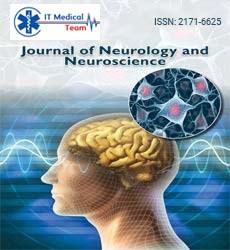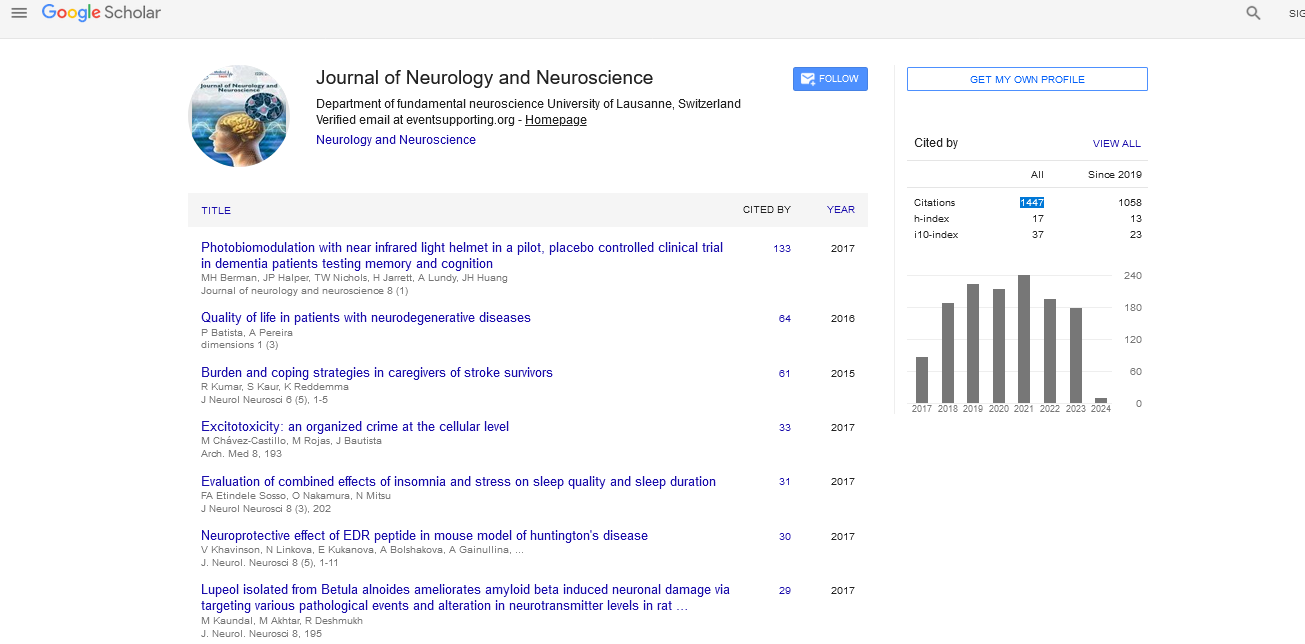Opinion - (2024) Volume 15, Issue 4
Exploring the mechanisms of action in neuromodulation therapies
Marius Militaru*
Department of Neuroscience, University of Medicine and Pharmacy, Municipal Emergency Hospital Timisoara, 300041 Timisoara, Romania
*Correspondence:
Marius Militaru, Department of Neuroscience, University of Medicine and Pharmacy, Municipal Emergency Hospital Timisoara, 300041 Timisoara,
Romania,
Email:
Received: 01-Aug-2024, Manuscript No. ipjnn-24-15288;
Editor assigned: 03-Aug-2024, Pre QC No. P-15288;
Reviewed: 15-Aug-2024, QC No. Q-15288;
Revised: 21-Aug-2024, Manuscript No. R-15288;
Published:
28-Aug-2024
Introduction
Neuromodulation therapies have gained significant attention in recent years for their potential to treat a range of neurological and psychiatric disorders. These therapies, which include Deep Brain Stimulation (DBS), Transcranial Magnetic Stimulation (TMS), and Spinal Cord Stimulation (SCS), aim to alter neuronal activity through the application of electrical or magnetic stimulation. Understanding the underlying mechanisms of action is crucial for optimizing these therapies, developing new techniques, and identifying the most appropriate patient populations. This article will delve into the key mechanisms of action of various neuromodulation therapies, their applications, and the ongoing research that continues to expand our knowledge in this field. Neuromodulation refers to the process by which a substance (neurotransmitter, hormone, or drug) influences a large number of neurons, typically involving changes in the strength of synaptic connections. Neuromodulation therapies can be classified into invasive and non-invasive techniques. Invasive techniques include DBS and SCS, while non-invasive methods encompass TMS and transcranial Direct Current Stimulation (tDCS). These therapies have demonstrated efficacy in treating conditions such as Parkinson’s disease, epilepsy, chronic pain, depression, and obsessive-compulsive disorder. Despite their success, the precise mechanisms by which they exert their effects remain an area of active investigation. DBS involves the implantation of electrodes in specific brain regions, delivering electrical pulses to modulate neuronal activity. This therapy is primarily used for movement disorders, especially Parkinson’s disease, but has also been explored for psychiatric conditions [1].
DBS primarily exerts its effects by inhibiting pathological neuronal firing in targeted brain areas. For instance, in Parkinson’s disease, stimulation of the Subthalamic Nucleus (STN) can reduce the excessive activity of basal ganglia circuits that contribute to motor symptoms. DBS influences the release of various neurotransmitters, including dopamine, serotonin, and Gamma-Aminobutyric Acid (GABA). These changes can enhance the efficacy of neurotransmission and promote overall neural health. DBS does not only target the site of stimulation but also affects interconnected brain regions. This network-level modulation can lead to widespread changes in brain function, which may account for some of the observed clinical benefits beyond the primary targeted area. Chronic DBS may induce neuroplastic changes, including synaptic strengthening or weakening, which can lead to long-term improvements in motor function and other symptoms. DBS has been widely used to manage Parkinson’s disease and essential tremor, with promising results. It is also being explored for treatment-resistant depression and obsessive-compulsive disorder. Understanding the mechanisms of action of DBS can help refine its application, improve patient selection, and optimize stimulation parameters. TMS is a non-invasive technique that uses magnetic fields to induce electrical currents in the brain. It has gained popularity as a treatment for major depressive disorder and has shown potential for other psychiatric and neurological conditions. The mechanisms by which TMS affects neuronal activity are still being elucidated but can be summarized as follows. TMS can target specific brain regions, such as the prefrontal cortex, to modulate neuronal excitability. By applying repetitive TMS (rTMS), researchers can increase or decrease the excitability of neurons in targeted areas.
TMS can induce Long-Term Potentiation (LTP) or Long-Term Depression (LTD) in synaptic connections, depending on the frequency and pattern of stimulation. This plasticity is thought to underlie the therapeutic effects of TMS in conditions like depression. TMS influences neurotransmitter release, particularly serotonin and dopamine. These changes may contribute to the alleviation of depressive symptoms and other mood disorders. TMS may also affect functional connectivity between different brain regions. By modulating the activity of specific cortical areas, TMS can influence broader brain networks involved in mood regulation and cognition. TMS has been FDA-approved for treatment-resistant depression and has shown promise in treating anxiety disorders, Post-Traumatic Stress Disorder (PTSD), and even chronic pain. Research continues to explore optimal stimulation parameters and patient selection criteria to enhance efficacy. SCS involves the implantation of a device that delivers electrical impulses to the spinal cord, providing relief from chronic pain. This therapy is particularly effective for neuropathic pain and failed back surgery syndrome [2,3].
Description
SCS is thought to operate on the principle of the gate control theory of pain, which posits that non-painful input (the electrical stimulation) can close the “gates” to painful input in the nervous system. This reduces the perception of pain. SCS can influence the release of endogenous opioids and other neurotransmitters that modulate pain perception, contributing to analgesic effects. By altering the excitability of neurons in the dorsal horn of the spinal cord, SCS can reduce the transmission of pain signals to the brain. SCS may change the way pain signals are processed, leading to altered pain perception. This can result in a more tolerable experience of pain, even if the underlying condition remains unchanged. SCS is widely used for chronic pain management, especially in patients with neuropathic pain. Ongoing research is focused on refining stimulation parameters, exploring new electrode designs, and investigating the potential use of SCS for conditions beyond pain, such as mood disorders and autonomic dysfunction [4].
As neuromodulation therapies continue to evolve, several promising avenues for future research and development emerge: Advancements in neuroimaging and genetic profiling may enable the identification of specific biomarkers that predict response to neuromodulation therapies. Tailoring treatment based on individual patient characteristics could enhance efficacy and minimize adverse effects. Combining neuromodulation therapies with pharmacological treatments or behavioral interventions may lead to synergistic effects. Research exploring these combinations can provide deeper insights into optimizing treatment plans for various disorders. Innovations in neuromodulation techniques, such as focused ultrasound and closed-loop systems, hold promise for more precise and adaptable therapies. These technologies may enhance the safety and efficacy of neuromodulation approaches. Continued exploration of the cellular and molecular mechanisms underlying neuromodulation is crucial for refining existing therapies and developing new interventions. Advances in neurobiology, coupled with interdisciplinary collaborations, can lead to transformative breakthroughs in understanding and treating complex neurological and psychiatric disorders [5].
Conclusion
Neuromodulation therapies have emerged as powerful tools in the management of various neurological and psychiatric conditions. By exploring the underlying mechanisms of action, researchers can better understand how these therapies exert their effects, ultimately leading to improved treatment outcomes. As technology advances and our understanding of the brain deepens, the future of neuromodulation holds great promise for enhancing the quality of life for patients suffering from debilitating disorders. Continued research and innovation will be vital in unlocking the full potential of these transformative therapies.
Acknowledgement
None.
Conflict of Interest
None.
References
- Katzman R, Hussey F. A simple constant‐infusion manometric test for measurement of CSF absorption: I. Rationale and method. Neurology. 1970; 20(6):534.
Google Scholar, Crossref, Indexed at
- Kosteljanetz M. Resistance to outflow of cerebrospinal fluid determined by bolus injection technique and constant rate steady state infusion in humans. Neurosurg. 1985; 16(3):336-340.
Google Scholar, Crossref, Indexed at
- Lenfeldt N, Koskinen LO, Bergenheim AT, et al. CSF pressure assessed by lumbar puncture agrees with intracranial pressure. Neurology. 2007; 68(2):155-158.
Google Scholar, Crossref, Indexed at
- Klarica M, Radoš M, Erceg G, et al. Cerebrospinal fluid micro-volume changes inside the spinal space affect intracranial pressure in different body positions of animals and phantom. Front Mol Neurosci. 2022; 15:931091.
Google Scholar, Crossref, Indexed at
- Dreha-Kulaczewski S, Joseph AA, Merboldt KD, et al. Inspiration is the major regulator of human CSF flow. J Neurosci. 2015; 35(6):2485-2491.
Google Scholar, Crossref, Indexed at





